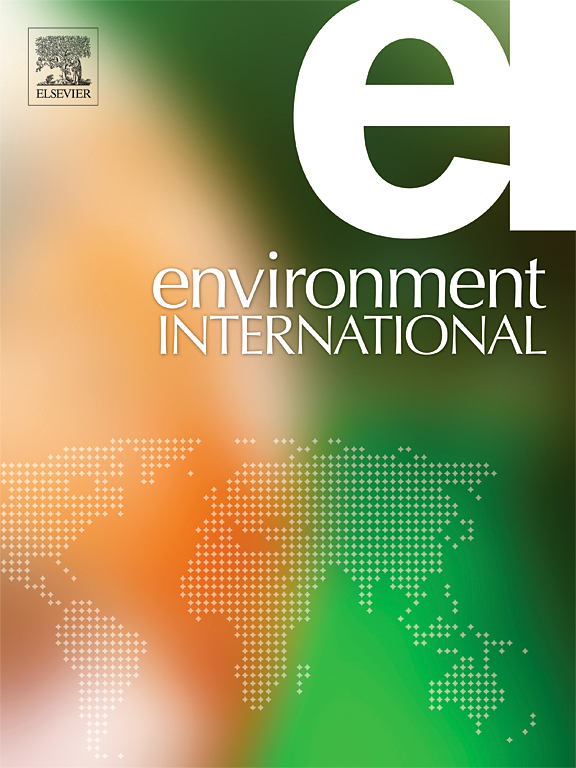Per- and polyfluoroalkyl substances, genetic factors, and sleep health in reproductive-aged women: a cross-sectional study of the Shanghai Birth Cohort
IF 9.7
1区 环境科学与生态学
Q1 ENVIRONMENTAL SCIENCES
引用次数: 0
Abstract
Perfluoroalkyl and polyfluoroalkyl substances (PFAS) may exert neurotoxic effects and disrupt endocrine function. However, the relationship between PFAS exposure and sleep disturbances in reproductive-aged women, and its interaction with genetic susceptibility, remains unclear. This study included 971 women from the Shanghai Birth Cohort preconception cohort. A total of 22 PFAS were measured in plasma, and sleep quality was assessed using the Pittsburgh Sleep Quality Index. Modified Poisson regression and quantile g-computation models estimated the effects of individual PFAS and PFAS mixtures on sleep disturbances. Polygenic risk scores were used to evaluate the cumulative genetic effects of sleep disturbances. 6:2Cl-PFESA was associated with increased snoring and less daytime dysfunction, though these associations did not remain significant after FDR correction. Exposure to PFAS mixtures was significantly associated with an increased risk of snoring (RR: 2.02, 95 % CI: 1.06–3.83). Significant associations between PFNA, PFDA, branched PFOS isomers, and chlorinated PFOS alternatives and increased snoring risk were observed in women with a high genetic predisposition. PFAS exposures and genetic variants showed additive effects on snoring risk, with RERI of 1.19 for PFNA, 1.06 for PFDA, 4.18 for 8: 2Cl – PFESA, 0.43 for 6: 2Cl – PFESA, 5.96 for 3 m-PFOS, 11.11 for 1 m – PFOS, and 0.40 for n-PFOS. These findings suggest PFAS exposure, particularly emerging alternatives and isomers of PFOS, may increase snoring risk in reproductive-aged women with a higher genetic predisposition.


全氟和多氟烷基物质、遗传因素和育龄妇女的睡眠健康:上海出生队列的横断面研究
全氟烷基和多氟烷基物质(PFAS)可能具有神经毒性作用并扰乱内分泌功能。然而,PFAS暴露与育龄妇女睡眠障碍之间的关系及其与遗传易感性的相互作用尚不清楚。本研究包括971名来自上海出生队列孕前队列的妇女。在血浆中测量了22种PFAS,并使用匹兹堡睡眠质量指数评估睡眠质量。修正的泊松回归和分位数g计算模型估计了单个PFAS和PFAS混合物对睡眠障碍的影响。多基因风险评分用于评估睡眠障碍的累积遗传影响。6:2 cl - pfea与打鼾增加和白天功能障碍减少有关,尽管这些关联在罗斯福纠正后并不显着。暴露于PFAS混合物与打鼾风险增加显著相关(RR: 2.02, 95 % CI: 1.06-3.83)。在高遗传易感的女性中观察到PFNA、PFDA、支链PFOS异构体和氯化PFOS替代品与打鼾风险增加之间的显著关联。PFAS暴露和遗传变异对打鼾风险表现出累加效应,PFNA的rei为1.19,PFDA为1.06,8:2Cl - PFESA为4.18,6:2Cl - PFESA为0.43,3 m-PFOS为5.96,1 m -PFOS为11.11,n-PFOS为0.40。这些发现表明,接触全氟辛烷磺酸,特别是新出现的全氟辛烷磺酸替代品和异构体,可能会增加遗传易感的育龄妇女打鼾的风险。
本文章由计算机程序翻译,如有差异,请以英文原文为准。
求助全文
约1分钟内获得全文
求助全文
来源期刊

Environment International
环境科学-环境科学
CiteScore
21.90
自引率
3.40%
发文量
734
审稿时长
2.8 months
期刊介绍:
Environmental Health publishes manuscripts focusing on critical aspects of environmental and occupational medicine, including studies in toxicology and epidemiology, to illuminate the human health implications of exposure to environmental hazards. The journal adopts an open-access model and practices open peer review.
It caters to scientists and practitioners across all environmental science domains, directly or indirectly impacting human health and well-being. With a commitment to enhancing the prevention of environmentally-related health risks, Environmental Health serves as a public health journal for the community and scientists engaged in matters of public health significance concerning the environment.
 求助内容:
求助内容: 应助结果提醒方式:
应助结果提醒方式:


